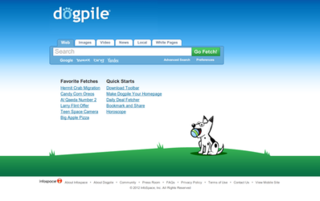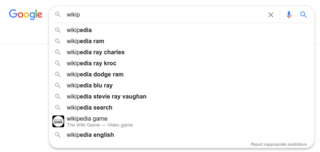Meta elements are tags used in HTML and XHTML documents to provide structured metadata about a Web page. They are part of a web page's head section. Multiple Meta elements with different attributes can be used on the same page. Meta elements can be used to specify page description, keywords and any other metadata not provided through the other head elements and attributes.
In computing, a search engine is an information retrieval software system designed to help find information stored on one or more computer systems. Search engines discover, crawl, transform, and store information for retrieval and presentation in response to user queries. The search results are usually presented in a list and are commonly called hits. The most widely used type of search engine is a web search engine, which searches for information on the World Wide Web.
Spamdexing is the deliberate manipulation of search engine indexes. It involves a number of methods, such as link building and repeating unrelated phrases, to manipulate the relevance or prominence of resources indexed in a manner inconsistent with the purpose of the indexing system.
Search engine optimization (SEO) is the process of improving the quality and quantity of website traffic to a website or a web page from search engines. SEO targets unpaid traffic rather than direct traffic or paid traffic. Unpaid traffic may originate from different kinds of searches, including image search, video search, academic search, news search, and industry-specific vertical search engines.

On the World Wide Web, a link farm is any group of websites that all hyperlink to other sites in the group for the purpose of increasing SEO rankings. In graph theoretic terms, a link farm is a clique. Although some link farms can be created by hand, most are created through automated programs and services. A link farm is a form of spamming the index of a web search engine. Other link exchange systems are designed to allow individual websites to selectively exchange links with other relevant websites, and are not considered a form of spamdexing.
Internet research is the practice of using Internet information, especially free information on the World Wide Web, or Internet-based resources in research.
The deep web, invisible web, or hidden web are parts of the World Wide Web whose contents are not indexed by standard web search-engine programs. This is in contrast to the "surface web", which is accessible to anyone using the Internet. Computer scientist Michael K. Bergman is credited with inventing the term in 2001 as a search-indexing term.
Spam in blogs is a form of spamdexing which utilizes internet sites which allow content to be publicly posted, in order to artificially inflate their website ranking by linking back to their web pages. Backlink helps search algorithms determine the popularity of a web page, which plays a major role for search engines like Google and Microsoft Bing to decide a web page ranking on a certain search query. This helps the spammer's website to list ahead of other sites for certain searches, which helps them to increase the number of visitors to their website.

Dogpile is a metasearch engine for information on the World Wide Web that fetches results from Google, Yahoo!, Yandex, Bing, and other popular search engines, including those from audio and video content providers such as Yahoo!.
Doorway pages are web pages that are created for the deliberate manipulation of search engine indexes (spamdexing). A doorway page will affect the index of a search engine by inserting results for particular phrases while sending visitors to a different page. Doorway pages that redirect visitors without their knowledge use some form of cloaking. This usually falls under Black Hat SEO.
Keyword stuffing is a search engine optimization (SEO) technique, considered webspam or spamdexing, in which keywords are loaded into a web page's meta tags, visible content, or backlink anchor text in an attempt to gain an unfair rank advantage in search engines. Keyword stuffing may lead to a website being temporarily or permanently banned or penalized on major search engines. The repetition of words in meta tags may explain why many search engines no longer use these tags. Nowadays, search engines focus more on the content that is unique, comprehensive, relevant, and helpful that overall makes the quality better which makes keyword stuffing useless, but it is still practiced by many webmasters.
Federated search retrieves information from a variety of sources via a search application built on top of one or more search engines. A user makes a single query request which is distributed to the search engines, databases or other query engines participating in the federation. The federated search then aggregates the results that are received from the search engines for presentation to the user. Federated search can be used to integrate disparate information resources within a single large organization ("enterprise") or for the entire web.

A search engine is a software system that provides hyperlinks to web pages and other relevant information on the Web in response to a user's query. The user inputs a query within a web browser or a mobile app, and the search results are often a list of hyperlinks, accompanied by textual summaries and images. Users also have the option of limiting the search to a specific type of results, such as images, videos, or news.
A search engine results page (SERP) is a webpage that is displayed by a search engine in response to a query by a user. The main component of a SERP is the listing of results that are returned by the search engine in response to a keyword query.
Search engine indexing is the collecting, parsing, and storing of data to facilitate fast and accurate information retrieval. Index design incorporates interdisciplinary concepts from linguistics, cognitive psychology, mathematics, informatics, and computer science. An alternate name for the process, in the context of search engines designed to find web pages on the Internet, is web indexing.
Adversarial information retrieval is a topic in information retrieval related to strategies for working with a data source where some portion of it has been manipulated maliciously. Tasks can include gathering, indexing, filtering, retrieving and ranking information from such a data source. Adversarial IR includes the study of methods to detect, isolate, and defeat such manipulation.
PolyCola, previously known as GahooYoogle, is a metasearch engine which was created by Arbel Hakopian.
A Web query topic classification/categorization is a problem in information science. The task is to assign a Web search query to one or more predefined categories, based on its topics. The importance of query classification is underscored by many services provided by Web search. A direct application is to provide better search result pages for users with interests of different categories. For example, the users issuing a Web query "apple" might expect to see Web pages related to the fruit apple, or they may prefer to see products or news related to the computer company. Online advertisement services can rely on the query classification results to promote different products more accurately. Search result pages can be grouped according to the categories predicted by a query classification algorithm. However, the computation of query classification is non-trivial. Different from the document classification tasks, queries submitted by Web search users are usually short and ambiguous; also the meanings of the queries are evolving over time. Therefore, query topic classification is much more difficult than traditional document classification tasks.
DeepPeep was a search engine that aimed to crawl and index every database on the public Web. Unlike traditional search engines, which crawl existing webpages and their hyperlinks, DeepPeep aimed to allow access to the so-called Deep web, World Wide Web content only available via for instance typed queries into databases. The project started at the University of Utah and was overseen by Juliana Freire, an associate professor at the university's School of Computing WebDB group. The goal was to make 90% of all WWW content accessible, according to Freire. The project ran a beta search engine and was sponsored by the University of Utah and a $243,000 grant from the National Science Foundation. It generated worldwide interest.

Searx is a free and open-source metasearch engine, available under the GNU Affero General Public License version 3, with the aim of protecting the privacy of its users. To this end, Searx does not share users' IP addresses or search history with the search engines from which it gathers results. Tracking cookies served by the search engines are blocked, preventing user-profiling-based results modification. By default, Searx queries are submitted via HTTP POST, to prevent users' query keywords from appearing in webserver logs. Searx was inspired by the Seeks project, though it does not implement Seeks' peer-to-peer user-sourced results ranking.





